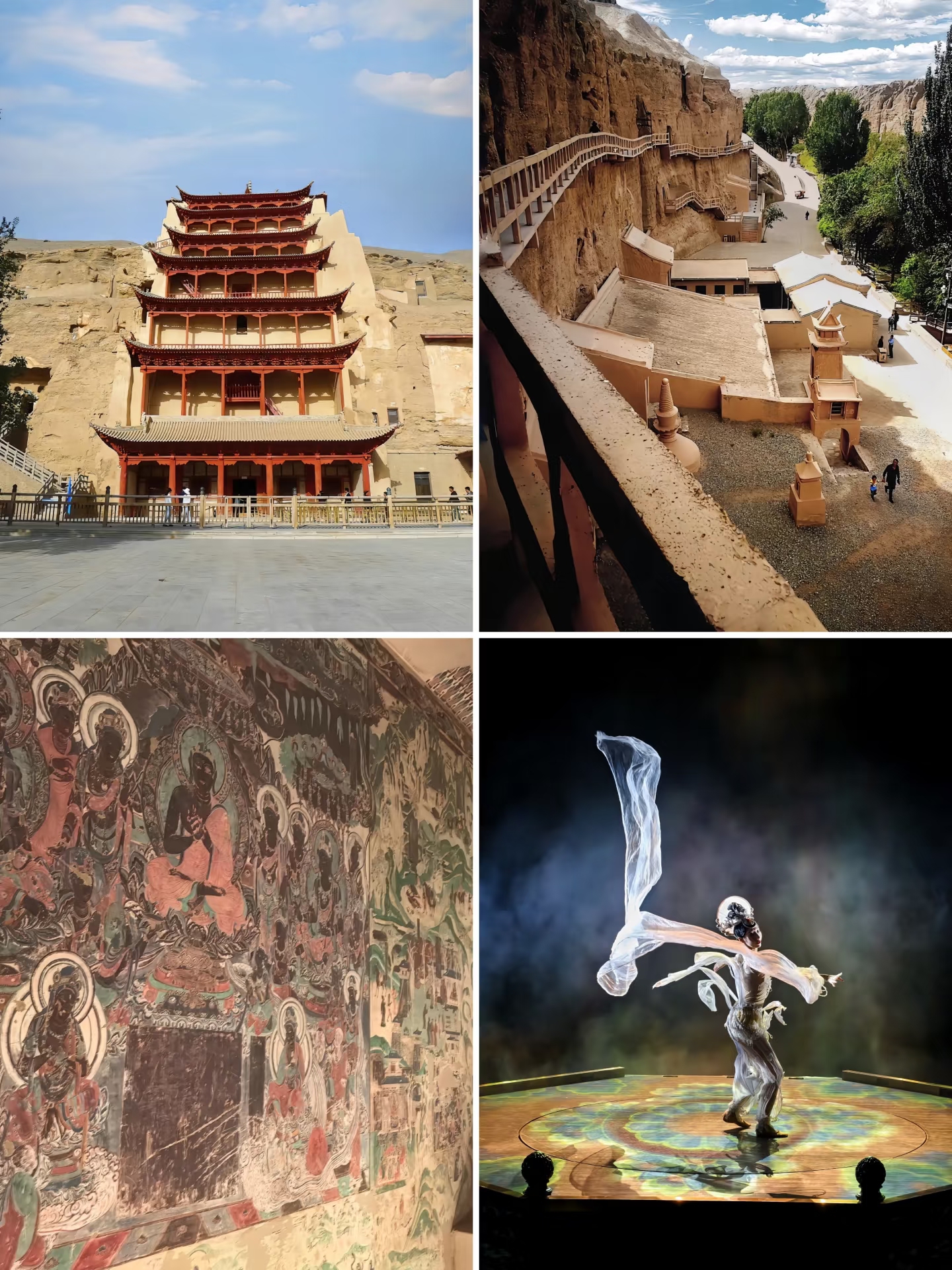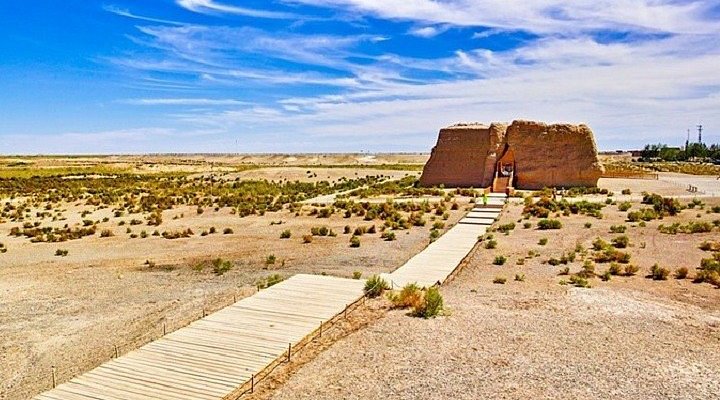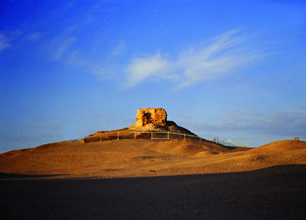Yangguan Pass Ruins: A Fascinating Insight into China’s Silk Road Legacy

An Essential Guide to Visiting Yangguan Pass Ruins
Nestled in the arid expanse of Gansu Province, the Yangguan Pass Ruins stand as a poignant reminder of China’s storied past along the legendary Silk Road. Once a bustling customs post and military stronghold, this site echoes with the footsteps of countless traders, monks, and explorers who traversed the rugged terrain in search of fortune and knowledge. Today, visitors are invited to wander through the remnants of ancient fortifications, gaze upon the solitary beacon tower that once signaled safety amidst the vast desert, and marvel at the breathtaking vistas that stretch towards the horizon.
As you step into this historic landscape, you’ll find a captivating blend of cultural heritage and natural beauty. The reconstructed fortress and accompanying museum offer a window into the lives of those who passed through this gateway to the unknown, while the surrounding scenery—punctuated by snow-capped mountains and sweeping desert dunes—provides a stunning backdrop for reflection and exploration. Whether you are a history enthusiast eager to uncover the tales of the past or a traveler in search of serene desert landscapes, Yangguan Pass promises an unforgettable journey through time and tradition. Embrace the spirit of adventure as you delve into this remarkable site, where every stone and whisper of the wind tells a story of resilience and discovery.
In This Guide
- An Essential Guide to Visiting Yangguan Pass Ruins
- The Rich History and Legends of Yangguan Pass Ruins
- Main Highlights: What You Absolutely Can’t Miss
- Planning Your Visit: A Practical Guide
- Tickets: Prices, Booking, and Tips
- How to Get There: A Complete Transportation Guide
- Local Cuisine and Accommodation Nearby
- Frequently Asked Questions
- Final Thoughts on Your Trip
The Rich History and Legends of Yangguan Pass Ruins
Nestled on the ancient Silk Road, the Yangguan Pass Ruins stand as a captivating testament to centuries of history and the vibrant legends that have shaped this remarkable landscape. Dating back to the Western Han Dynasty, Yangguan Pass served as a crucial military stronghold and customs checkpoint, guarding the western frontier of China and facilitating trade and cultural exchange along this historic route.
The significance of Yangguan Pass cannot be overstated. It was here that countless merchants, travelers, and envoys embarked on their journeys into the vast unknown beyond the Chinese borders. The pass became a gateway to adventure, discovery, and, for many, a final farewell, as it was said that those who ventured beyond the gate often did not return. This sentiment is echoed in the poetry of the Tang Dynasty, where Yangguan inspired verses that capture both the beauty and melancholy of departure.
Visitors today will find that the remnants of the pass are steeped in historical richness. The reconstructed Yangguan Fortress and the imposing Beacon Tower serve as focal points within the scenic area, providing a glimpse into the military architecture that once dominated this strategic location. The ancient path, lined with tales of warriors and traders, leads to the Shouchang City Ruins, where one can almost hear the echoes of bustling activity that characterized this once-thriving hub.
The Yangguan Pass Museum adds another layer to the experience, showcasing over 4,000 artifacts, including pottery, jade, and weapons, many dating back to the Han Dynasty. The museum’s exhibitions delve into the construction and historical significance of Yangguan and its counterpart, the Yumen Pass, illustrating how these two sites were pivotal in shaping the dynamics of the Silk Road.
As you wander through the ruins, the stark beauty of the surrounding landscape enhances the historical narrative. The desolate terrain, dotted with remnants of ancient architecture, is framed by the majestic backdrop of snow-capped mountains, creating a panorama that inspires contemplation of the lives that once unfolded here.
Whether you are a history enthusiast or a curious traveler, the Yangguan Pass Ruins invite you to step back in time and immerse yourself in the rich tapestry of stories that have shaped this extraordinary place. From the legendary departures of the past to the modern-day explorations, Yangguan continues to resonate with a sense of adventure and discovery, making it a must-visit destination on your journey through China’s storied history.

Yangguan Pass Ruins.
Main Highlights: What You Absolutely Can’t Miss
When visiting the Yangguan Pass Ruins, a treasure trove steeped in history along the ancient Silk Road, there are several highlights that you absolutely cannot miss. This site, once a bustling customs post, is now an evocative reminder of the past, set against a stunning desert landscape.
1. Yangguan Pass Fortress
At the heart of the ruins lies the reconstructed Yangguan Pass Fortress. This impressive site transports you back to the days of the Han Dynasty, showcasing the strategic military architecture that once protected this critical juncture of trade and travel. The fortress’s walls and layout, meticulously reconstructed based on historical records, offer a glimpse into the defensive strategies of ancient China.
2. Yangguan Beacon Tower
Standing tall amidst the vast desert expanse, the Yangguan Beacon Tower is a must-see. This iconic structure served as a lookout point and communication hub for military forces. Its solitary presence against the backdrop of snow-capped mountains creates a breathtaking panorama, perfect for photography enthusiasts. Make sure to capture the moment as you stand where ancient sentinels once watched over the Silk Road travelers.
3. Yangguan Ancient Path
Walking along the Yangguan Ancient Path is like stepping into a time machine. This historic route once facilitated the movement of merchants, monks, and travelers. As you stroll along the path, take a moment to imagine the myriad stories that unfolded here, each footstep echoing the past. The surrounding landscape is equally captivating, with sweeping views of the desert that will leave you in awe.
4. Shouchang City Ruins
Adjacent to the main site, the Shouchang City Ruins offer further insights into the region’s historical significance. These remnants tell tales of a once-thriving city that played a vital role in the Silk Road’s network. Explore the ruins and let your imagination guide you through the ancient streets where life bustled in centuries gone by.
5. Yangguan Pass Museum
Don’t miss the Yangguan Pass Museum, which houses an impressive collection of artifacts from the Han Dynasty. With over 4,000 displays including pottery, jade, stone stools, and weapons, the museum provides a deep dive into the cultural and historical context of the area. Be sure to check out the exhibition on the Two Frontier Passes, which chronicles the construction and impact of Yangguan and its rival, Yumen Pass.
6. Experiential Activities
For a taste of ancient customs, participate in some of the experiential activities available at the site. Try your hand at pottery, archery, or even partake in a traditional farewell ritual at the Yangguan Gate, where travelers historically bade farewell to friends before venturing into the unknown.
7. Scenic Views
Finally, take the time to soak in the mesmerizing desert vistas. The contrasts of the arid landscape with the distant snow-capped mountains create an unforgettable visual experience. Whether you’re hiking or simply enjoying a moment of reflection, the serene beauty surrounding Yangguan Pass is a perfect way to connect with the historical weight of this iconic location.
Embarking on a journey to the Yangguan Pass Ruins is not just a visit to a historical site; it’s an adventure into the very heart of the Silk Road. Each highlight offers a unique perspective on the rich tapestry of history, culture, and breathtaking landscapes. Don’t miss the chance to explore this remarkable destination!

Yangguan Pass Ruins.
Planning Your Visit: A Practical Guide
Planning Your Visit: A Practical Guide to Yangguan Pass Ruins
Visiting the Yangguan Pass Ruins is an unforgettable experience that takes you back to the ancient Silk Road days. Nestled in the scenic landscape of Dunhuang, this historical site offers a glimpse into China’s rich cultural heritage. Here’s everything you need to know to make the most of your visit.
Getting There
Location: The Yangguan Pass Ruins are situated approximately 70 miles southwest of Dunhuang, making it easily accessible for day trips.
Transportation Options:
– Tour Buses: There are low-cost tour buses operating from Dunhuang that visit Yangguan along with other historical sites like Yadan Geopark. Be prepared for a full-day excursion.
– Private Car Hire: For more flexibility, consider hiring a car. Rates typically range from $60 to $70, allowing you to explore at your own pace.
Best Time to Visit
The ideal time to visit Yangguan Pass is during the spring (April to June) and autumn (September to October) months when the weather is mild and the landscape is at its most picturesque. Summer temperatures can soar, while winter may bring chilly winds, so dress accordingly.
Entrance Fees and Hours
- Admission Fee: Check for the latest prices, but expect a reasonable entrance fee that covers access to the museum and the ruins.
- Hours: The site is generally open from morning until late afternoon, but confirm local hours before your visit as they can vary.
What to Expect
Once you arrive, prepare for a journey through history:
- Museum: Start your visit at the Yangguan Pass Museum, which showcases over 4,000 exhibits, including ancient pottery, jade artifacts, and weaponry from the Han Dynasty.
- Ruins and Reconstructions: Wander through the reconstructed Yangguan Fortress and the Beacon Tower, both of which provide fascinating insight into the strategic importance of this location.
- Ancient Path: Explore the Yangguan Ancient Path, where you can almost hear the echoes of travelers from centuries past.
Activities
- Photography: The desolate landscape, particularly with snow-capped mountains in the backdrop, creates stunning photo opportunities. Don’t forget your camera!
- Interactive Experiences: Engage in activities like pottery making and archery, which offer a fun glimpse into ancient crafts and skills.
- Cultural Immersion: Participate in traditional customs like the farewell wine ceremony at the Yangguan Gate to enrich your experience.
Nearby Attractions
While you’re in the area, consider visiting:
– Shouchang City Ruins: Discover more about the ancient civilization that once thrived here.
– Dunhuang Nanhu Lake: Relax and enjoy nature at this nearby scenic spot.
– Yumenguan Pass: Often compared to Yangguan, Yumenguan offers its own unique history and charm.
Tips for Travelers
- Dress Appropriately: Wear comfortable shoes for walking and dress in layers to accommodate fluctuating temperatures.
- Stay Hydrated: Bring water, especially if visiting during warmer months, as the desert climate can be dehydrating.
- Plan for Connectivity: Mobile service may be limited in remote areas, so download maps and information in advance.
Conclusion
A visit to the Yangguan Pass Ruins is a must for history enthusiasts and nature lovers alike. With its stunning landscapes and rich historical significance, it promises an enriching travel experience. Prepare for a journey through time as you walk in the footsteps of ancient travelers who once traversed this iconic Silk Road landmark. Enjoy your adventure!

Yangguan Pass Ruins.
Tickets: Prices, Booking, and Tips
Visiting the Yangguan Pass Ruins is a journey into the heart of ancient history, and planning your trip is essential to make the most of your experience. Here’s everything you need to know about tickets, booking options, and helpful tips for your visit.
Ticket Information
Tickets for the Yangguan Pass Ruins are reasonably priced, with entry fees typically ranging from ¥50 to ¥80 (approximately $7 to $11 USD). This price grants you access to the main attractions, including the Yangguan Fortress, the Beacon Tower, and the Yangguan Museum, which showcases fascinating relics from the Han Dynasty.
Booking Options
While you can purchase tickets directly at the entrance, it’s advisable to book in advance, especially during peak tourist seasons (spring and autumn). Several tour operators offer packages that include transportation from Dunhuang, which can enhance your visit. Here are some popular options:
- Private Dunhuang Day Tour: Approximately $288 for a full day, including visits to the Yadan Geopark and other historical sites.
- Silk Road Hiking Day Tour: Starting at $279, this tour includes a guided hiking experience at Yangguan.
- Multi-Day Tours: For those looking to delve deeper into the history of the Silk Road, consider a 2-day trip for around $635, which combines visits to Yangguan with other significant sites.
Tips for Your Visit
-
Plan Your Timing: The site is about an hour’s drive from Dunhuang. Consider starting your day early to avoid crowds and enjoy the serene desert landscape.
-
Transportation: If you prefer flexibility, renting a car is a great option. Expect to pay around $60-$70 for a day’s rental.
-
Dress Comfortably: The terrain can be rugged, and the weather can change quickly. Wear sturdy shoes and dress in layers to adapt to temperature fluctuations.
-
Stay Hydrated: The desert environment can be dry and hot, so carry water with you to stay refreshed during your exploration.
-
Capture the Scenery: Don’t forget your camera! The views from the fortress and the surrounding landscapes are breathtaking, especially with the snow-capped mountains in the distance.
-
Check the Calendar: Be mindful of local holidays and festivals, as these can affect crowd levels and availability.
By planning ahead and considering these tips, you can immerse yourself in the rich history of the Yangguan Pass Ruins and create unforgettable memories of your Silk Road adventure.
How to Get There: A Complete Transportation Guide
Reaching the Yangguan Pass Ruins (阳关遗址) is a captivating journey that immerses you in the rich history of the ancient Silk Road. Situated approximately 70 miles southwest of Dunhuang, this site is easily accessible via various modes of transportation that cater to international travelers. Here’s how you can make your way to this historical treasure.
By Air
Closest Airport:
– Dunhuang Airport (DNH): This is the nearest airport, located about 13 miles (20 kilometers) from Dunhuang’s city center.
Airlines:
– Several domestic airlines operate flights to Dunhuang from major cities like Beijing, Shanghai, and Xi’an. Check for seasonal international flights that might connect through these hubs.
By Train
Train to Dunhuang:
– If you prefer the scenic route, you can take a train to Dunhuang from major cities in China. The journey offers stunning views of the Gobi Desert landscape.
Train Station:
– Dunhuang Railway Station: After arriving, you can opt for local transportation to reach Yangguan Pass.
By Bus
Long-Distance Buses:
– From Dunhuang City: Buses run regularly from Dunhuang’s central bus station to Yangguan Pass. The trip typically takes about 1.5 hours.
– Tour Buses: Some low-cost tour buses also operate routes that include stops at Yangguan and other historical sites like the Yadan Geopark. These tours can last an entire day, so be prepared for a full schedule.
By Car
Rental Cars:
– Renting a car is a flexible option that allows you to explore at your own pace. Rental services are available in Dunhuang, and the drive to Yangguan Pass is straightforward, taking around one hour via the G30 highway.
Private Transfers:
– Alternatively, you can hire a driver for a more comfortable experience. Prices range from $60 to $70 USD for a day trip, which can be shared among fellow travelers to make it more economical.
Local Transportation in Dunhuang
Taxis and Ride-Sharing:
– Once in Dunhuang, taxis are readily available and can take you to the bus station or directly to Yangguan Pass. Ride-sharing apps may also operate in the area, offering another convenient option.
Public Transport:
– Public buses can be utilized to reach various points in Dunhuang, but they may not directly connect to Yangguan Pass. It’s advisable to check local schedules.
Recommended Tours
For those interested in a guided experience, consider booking a private tour that includes Yangguan Pass, as well as other notable sites in the region like the Mogao Grottoes or the Crescent Moon Spring. Tours typically last between 8 to 10 hours, offering insights into the history and culture of this fascinating area.
Final Tips
- Check Schedules: Whether traveling by bus or train, always check the latest schedules and availability, as they can vary seasonally.
- Language Barrier: English may not be widely spoken, so having a translation app or a phrasebook can be helpful.
- Travel Essentials: Bring water, snacks, and sun protection, as the desert climate can be harsh, especially during peak seasons.
Embarking on your journey to Yangguan Pass not only offers a glimpse into China’s storied past but also an opportunity to soak in the breathtaking desert vistas that surround this historic site. Safe travels!

Yangguan Pass Ruins.
Local Cuisine and Accommodation Nearby
When visiting the Yangguan Pass Ruins, travelers will find an array of delightful local cuisine and comfortable accommodations that enhance their experience of this historical site.
Local Cuisine
After exploring the ancient ruins and soaking in the stunning desert landscape, you’ll likely want to indulge in some local flavors. Here are a couple of recommended dining options nearby:
-
Dicos Chicken
Located near the Yangguan scenic area, this casual fast-food chain offers a taste of local cuisine in a familiar setting. Known for its crispy fried chicken and hearty sides, Dicos provides a quick and satisfying meal for travelers on the go. While it may not be the most traditional option, it’s a convenient stop after a long day of exploration. -
Local Noodle Shops
For a more authentic taste of the region, seek out one of the local noodle shops in the nearby town. These establishments often serve hand-pulled noodles with rich broths, fresh vegetables, and various meats. The flavors are bold and comforting, making for a perfect meal to recharge. -
Yangguan Restaurant
If you’re looking for a sit-down dining experience, Yangguan Restaurant is a great choice. They specialize in regional dishes, including lamb skewers and stir-fried seasonal vegetables, all seasoned with local spices that reflect the area’s culinary heritage.
Accommodation
To make the most of your visit, consider staying at one of these nearby accommodations that offer comfort and convenience:
-
Dunhuang Hotel
Situated about an hour’s drive from the Yangguan Pass, this hotel offers modern amenities with a touch of local charm. Guests can enjoy spacious rooms, an on-site restaurant, and easy access to local attractions. The hotel staff is known for their hospitality, making your stay comfortable and enjoyable. -
Silk Road Dunhuang Hotel
This elegant hotel is designed to reflect the rich history of the Silk Road. With beautifully decorated rooms, a restaurant serving both Western and Chinese cuisine, and a cozy bar, it provides a relaxing retreat after a day of exploring. The hotel also offers guided tours and transportation services to local sites. -
Hostel Options
For budget travelers, there are several hostels in Dunhuang that provide a friendly atmosphere and the chance to meet fellow adventurers. Places like the Dunhuang Youth Hostel offer dormitory-style accommodations and communal areas, making it easy to share stories and tips about the region.
Whether you’re savoring local dishes or unwinding in comfortable accommodations, your visit to the Yangguan Pass Ruins will be complemented by the flavors and hospitality of the surrounding area. Enjoy your journey through this remarkable part of history!

Yangguan Pass Ruins.
Frequently Asked Questions
-
What is the best time to visit Yangguan Pass Ruins?
The ideal time to visit Yangguan Pass Ruins is during the spring and autumn months (April to June and September to October) when the weather is mild and pleasant. Summers can be extremely hot, while winters may bring chilly temperatures. Early mornings or late afternoons also provide the best lighting for photography. -
How do I get to Yangguan Pass Ruins from Dunhuang?
You can reach Yangguan Pass Ruins by taking a low-cost tour bus from Dunhuang, which typically takes about an hour. Alternatively, you can hire a car for more flexibility. Many travelers combine their visit with other nearby attractions like Yumen Pass, making for a fulfilling day trip. -
Are there any entrance fees or tickets required?
Yes, there is an entrance fee to access the Yangguan Pass scenic area, which also includes entry to the museum and other historical sites. Be sure to check the latest prices online or at the entrance, as they may change seasonally. -
What can I expect to see at the site?
At Yangguan Pass Ruins, you can explore the reconstructed Ancient Yangguan Pass Fortress, the Yangguan Beacon Tower, the Ancient Path, and various remnants from the Han Dynasty, including a museum with thousands of historical artifacts. The stunning desert landscape and panoramic views are an added bonus. -
Is there food available at Yangguan Pass?
Yes, there are food options available within the site, including local eateries. However, choices may be limited, so it’s a good idea to bring snacks and water, especially if you plan to spend a significant amount of time exploring the ruins. -
Are there any guided tours available?
Absolutely! There are various guided tour options available, including private day tours that can be customized to your interests. These tours often include transportation, meals, and knowledgeable guides who can provide deeper insights into the history and significance of the site. -
What should I wear or bring for my visit?
Dress comfortably and wear sturdy shoes, as you may be walking on uneven terrain. Sunglasses, sunscreen, and a hat are recommended for sun protection, especially during the summer months. Bringing a camera to capture the breathtaking scenery is a must! -
Is Yangguan Pass suitable for families with children?
Yes, Yangguan Pass can be a family-friendly destination. Kids will enjoy exploring the open spaces and engaging with the historical significance of the site. However, keep an eye on younger children, especially in areas where there may be steep drops or uneven paths.
Final Thoughts on Your Trip
As you conclude your journey through the captivating remnants of Yangguan Pass, reflect on the stories whispered by the winds that once carried merchants, travelers, and warriors along this ancient Silk Road route. The echoes of history resonate in the desolate landscapes, where the ruins stand as a testament to a time when this pass was a vital gateway to the unknown.
Whether you were captivated by the magnificent views of the snow-capped mountains, intrigued by the relics housed in the museum, or inspired by the reconstructed fortress, Yangguan offers a profound connection to the past. Allow the serene atmosphere and the vastness of the desert to evoke a sense of wonder and contemplation as you leave this historic site.
Embrace the memories you’ve gathered here, and let them inspire your adventures ahead. The journey through Yangguan Pass is not just a glimpse into history; it is an invitation to reflect on the paths we travel, both in life and in exploration. Safe travels, and may your next destination be just as enriching!